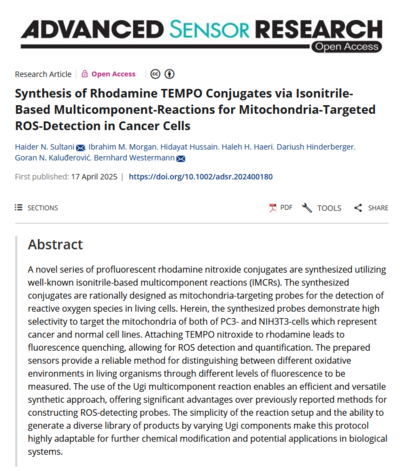New probes for early tumor detection
IPB chemists and their partners at Martin-Luther University Halle-Wittenberg (MLU) and the Merseburg University of Applied Sciences produced a series of profluorescent rhodamine-nitroxide conjugates using an isonitrile-based multicomponent reaction. These synthesized compounds can be used as mitochondria-specific probes to detect reactive oxygen species (ROS) in living cells. Excessive ROS formation causes cell damage, leading to oxidative stress and cell death. Cancer cells, in particular, are characterized by increased ROS production due to their high metabolic activity. Approximately 90 percent of the ROS formed in cancer cells originate from the mitochondria. Therefore, the probe designed by the Halle chemists is particularly suitable for detecting cancer cells.
Rhodamine is widely used in imaging applications. As a lipophilic, cationic dye, it passes through cell membranes and accumulates in the mitochondria. Its fluorescence intensity increases proportionally with ROS formation. However, as healthy cells also produce ROS compounds to a certain extent, rhodamine alone is not suitable for distinguishing cancer cells from normal cells.
For this reason, the Halle chemists have conjugated a nitroxide radical from the TEMPO group (2,2,6,6-tetramethylpiperidinyloxyl) in close proximity to the dye. Nitroxides can deactivate the excited state of fluorescent markers. The combination of rhodamine and TEMPO therefore makes the probe profluorescent, i.e. it fluoresces little or not at all in its normal state. In non-degenerate cells that produce only a small amount of ROS, the probe does not light up. In cancer cells with high ROS production, however, the TEMPO group is slowly damaged, thus no longer sufficient to permanently quench the fluorescence. The marker therefore becomes activated and marks the tumor cells.
Due to its unpaired delocalized electron, the TEMPO radical can also be used as a spin marker in electron paramagnetic resonance (EPR) spectroscopy. EPR spectroscopy is a powerful detection method based on analyzing the interaction of unpaired electrons with microwave radiation in the presence of a magnetic field. EPR spectroscopy has many applications, such as determining the structure of macromolecules and detecting free radicals in tissues. Incorporating TEMPO into the rhodamine marker makes the compound a dual-function probe that can be used in analyses with different modes of operation.
The scientists verified their approach using non-degenerate fibroblast and prostate cancer cell lines. Flow cytometry analysis and fluorescence microscopy of the cell cultures revealed that the rhodamine-TEMPO probe fluoresced only in the cancer cells. Meanwhile, the low ROS levels in the normal cells were insufficient to overcome the TEMPO barrier.
Rhodamine nitroxide probes therefore have great potential for use in early cancer detection and therapeutic monitoring in the future, the scientists conclude. Initial safety tests showed that, at the concentrations used, the probes have no significant effect on cell growth or mitochondrial function in normal or tumor cells. Therefore, their use would be safe from a toxicological point of view. Once again, the multicomponent reaction has proven to be an effective method for synthesizing new probes. Further modifications can easily be incorporated using these techniques, opening up new areas of application in targeted imaging.


